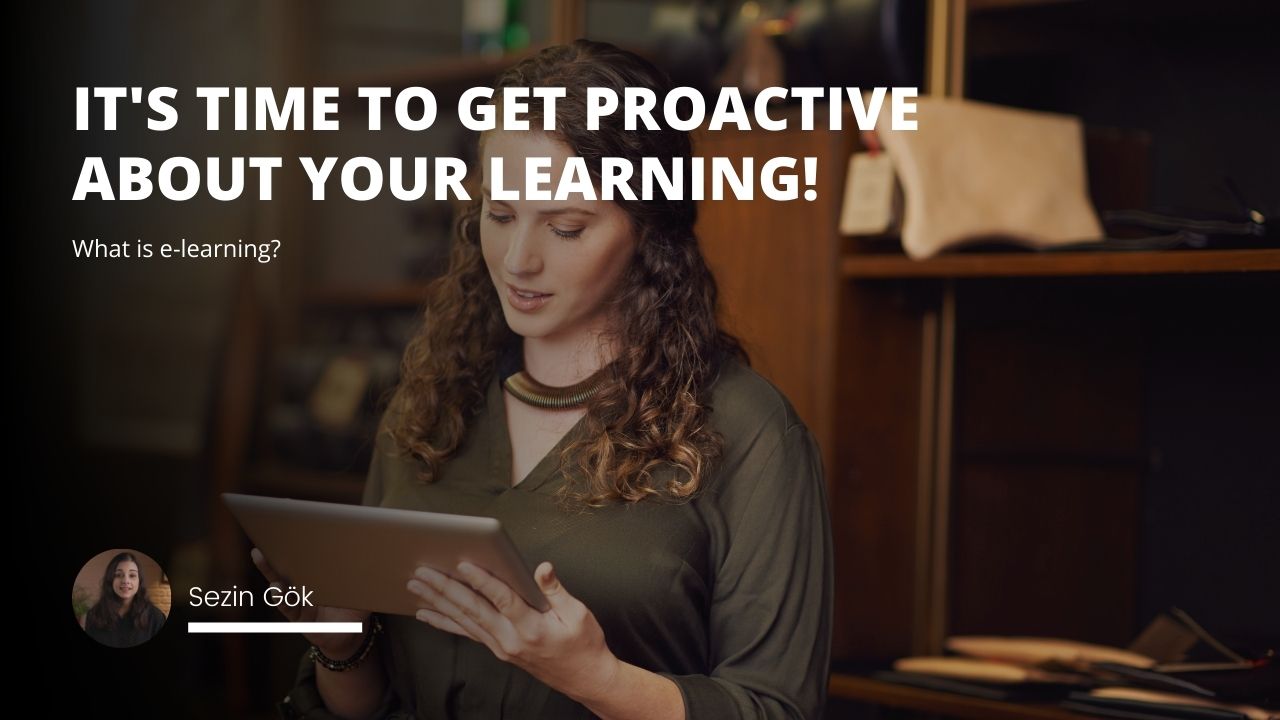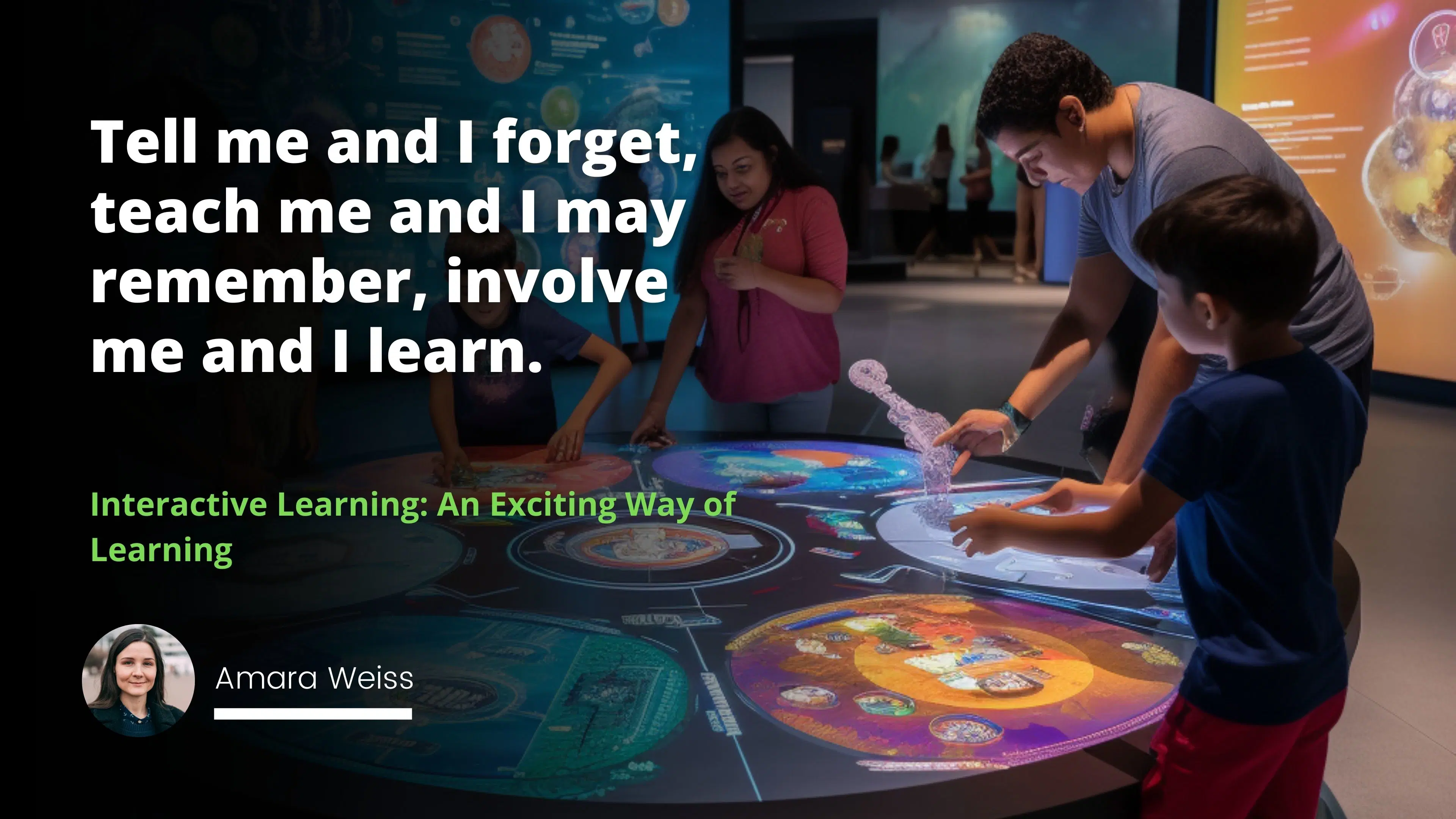
Interactive learning has come to reshape the entire landscape of education.
Interactive learning combines traditional teaching methods with modern technology. Its goal is to transform students from passive receivers of information into active participants in their learning journey.
This pedagogical approach promotes student engagement, collaboration, critical thinking, and metamemory development.
Interactive learning goes beyond just accumulating knowledge. It also involves processing, comprehending, and applying the information in different contexts.
This educational model revolutionizes learners' cognitive and metacognitive skills.
Unpacking Interactive Learning

Interactive learning is a forward-thinking educational approach that encourages learners to participate in their learning process actively. Educators can cultivate a stimulating, dynamic, and riveting educational milieu by integrating traditional teaching styles with present-day technology.
Interactive learning challenges the one-directional flow of instruction. In an interactive setup, the exchange of information between teachers and learners is bidirectional.
It allows students to be part of a lively academic environment.
More importantly, this learning model instigates learners to collaborate, solve problems, and think critically. It creates an environment where students feel comfortable to question concepts, share ideas, and find authentic solutions. Likewise, it promotes the growth of metacognitive skills among learners, helping them understand how they learn and process information.
Embracing the Two-Way Flow of Information:
Interactive learning challenges the traditional, one-way flow of information from the teacher to the student. Instead, it fosters a more dynamic, bidirectional exchange.
The teacher shares knowledge. The students are encouraged to participate actively. They are also encouraged to ask questions, discuss perspectives, and contribute their understanding of topics.
Stimulating Collaborative Learning:
Cooperative learning tasks and collaboration are fundamental aspects of interactive learning methodologies. When students work together, they become intricately involved in their educational process. This initiates lively classroom discussions, problem-solving, and the development of critical soft skills such as communication and teamwork.
Promoting Metacognitive Development:
Also known as 'thinking about thinking,' metacognition is about knowing what we know and how we learn.
Interactive learning promotes the growth of metacognitive skills. These skills allow students to assess their learning methods, establish goals, reflect on their progress, and effectively manage their learning.
The Multifaceted Benefits of Interactive Learning
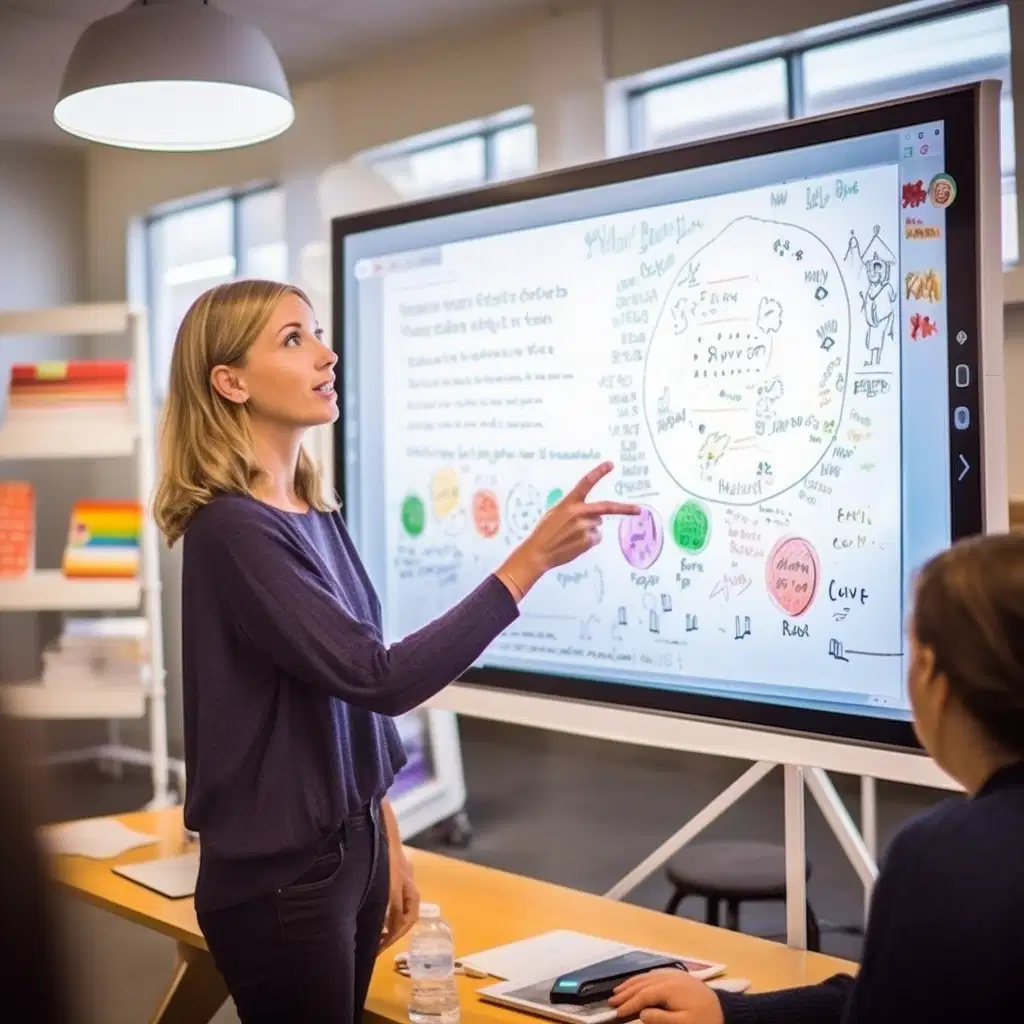
Embracing interactive learning can usher a myriad of advantages both in online and offline teaching setups.
1. Nurture Student Engagement: Interactive learning piques curiosity and fuels interest, leading to increased student engagement. Technologies like interactive whiteboards and virtual learning environments offer definitive explanations and stimulate discussions about complex concepts.
2. Boost Knowledge Retention: Active participation is at the heart of interactive learning. It fosters better recollection and comprehension of information. Learners are far more likely to remember actively acquired information than passively received.
Perfect Compensation And Benefits Package For Attracting And Retaining Top Talent
Learning And Development Opportunities For Personal And Professional Growth
3. Foster Collaboration and Motivation: Teamwork is essential in interactive learning tasks. This collaborative approach promotes a sense of community, instigates cooperation, and improves students' social and communication skills. Moreover, the innovation nests within interactive learning keep students motivated and enthusiastic about learning.
Advancing Student Engagement:
Interactive learning stimulates curiosity and interest among students by providing a more relatable and intriguing learning environment. Utilizing technology, like interactive whiteboards and virtual learning environments, can help break down complex concepts into digestible, exciting learning segments.
Reinforcing Knowledge Retention:
Information retention is improved when students are actively involved in their learning process.
Active participation in interactive learning includes more than just listening to a lecture. It also involves participating in live discussions, group work, and presentations.
Active participation in learning helps learners retain information better than traditional methods. This dynamic engagement allows learners to remember what they have learned more effectively.
Inspiring Motivation and Collaboration:
Interactive learning tasks require teamwork, which inherently fosters a supportive learning community. This shared educational experience encourages collaboration and vital communication skills. In addition, the innovative delivery of interactive learning keeps learners motivated and invested in their educational journey.
A Variety of Interactive Learning Methods
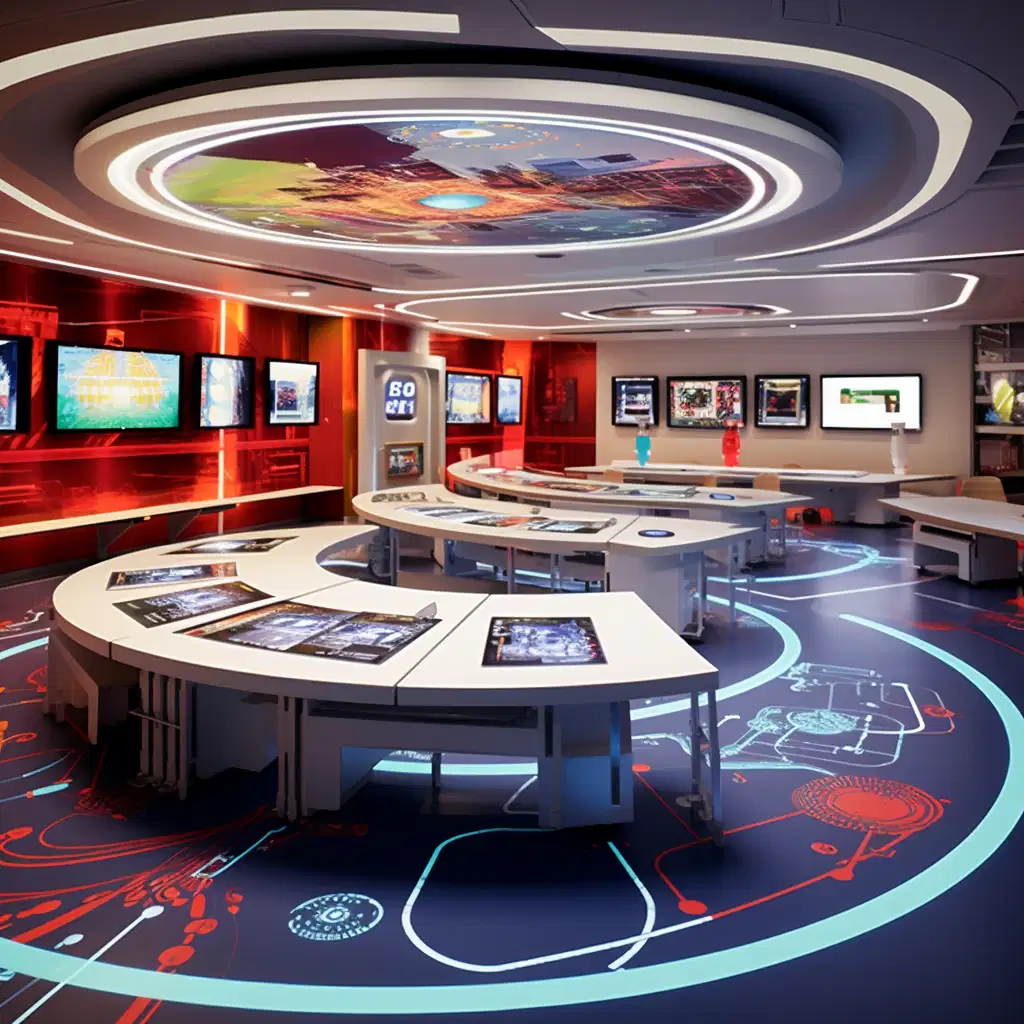
Interactive learning can take several forms and encompasses a diversity of teaching methods and tools:
Online Quizzes and Virtual Classrooms: Provide real-time interactivity, promoting active learner participation. Online platforms are becoming essential tools for distance learning, providing immediate learner feedback and giving teachers valuable insight into student comprehension.
Adaptive Platforms and Gamified Learning: Offer personalized learning experiences by adjusting to each student's pace and comprehension level. Game-design elements make the learning process entertaining and engaging.
Interactive Whiteboards and Video Conferencing: These tools foster visual engagement by allowing students to interact with content. Video conferencing breaks geographical barriers and allows real-time interactions and discussions.
Interactive Learning Solutions and Systems: Innovative systems and solutions are developed to address the increasing demand for interactive learning. They range from mobile learning applications that meld digital and traditional teaching methods to sophisticated interactive learning systems employing Artificial Intelligence (AI) for customization.
Tell me and I forget, teach me and I may remember, involve me and I learn.
Real-Time Interactions Through Online Quizzes and Virtual Classrooms
These tools allow engagement in real-time, fostering active participation from learners. Online educational platforms offer a wealth of benefits for interactive learning, such as immediate feedback to students, valuable insights for teachers about each learner's progress, and the creation of a lively virtual learning environment.
Personalized Learning with Adaptive Platforms and Gamified Learning
Adaptive learning technologies offer a concise and customized learning experience tailored to each student's pace and understanding. Meanwhile, gamified learning enhances the educational experience by introducing game-design elements to the learning process - a strategy makes learning more interactive and enjoyable.
Visual Engagement Using Interactive Whiteboards and Video Conferencing
In the age of remote learning, interactive whiteboards serve as an instrumental tool in promoting visual engagement and enhancing understanding of complex subjects. On the other hand, video conferencing has taken the spotlight by providing a platform for real-time interactions and collaborations, effectively eliminating geographical barriers.
Rethinking Assessment with Interactive Learning
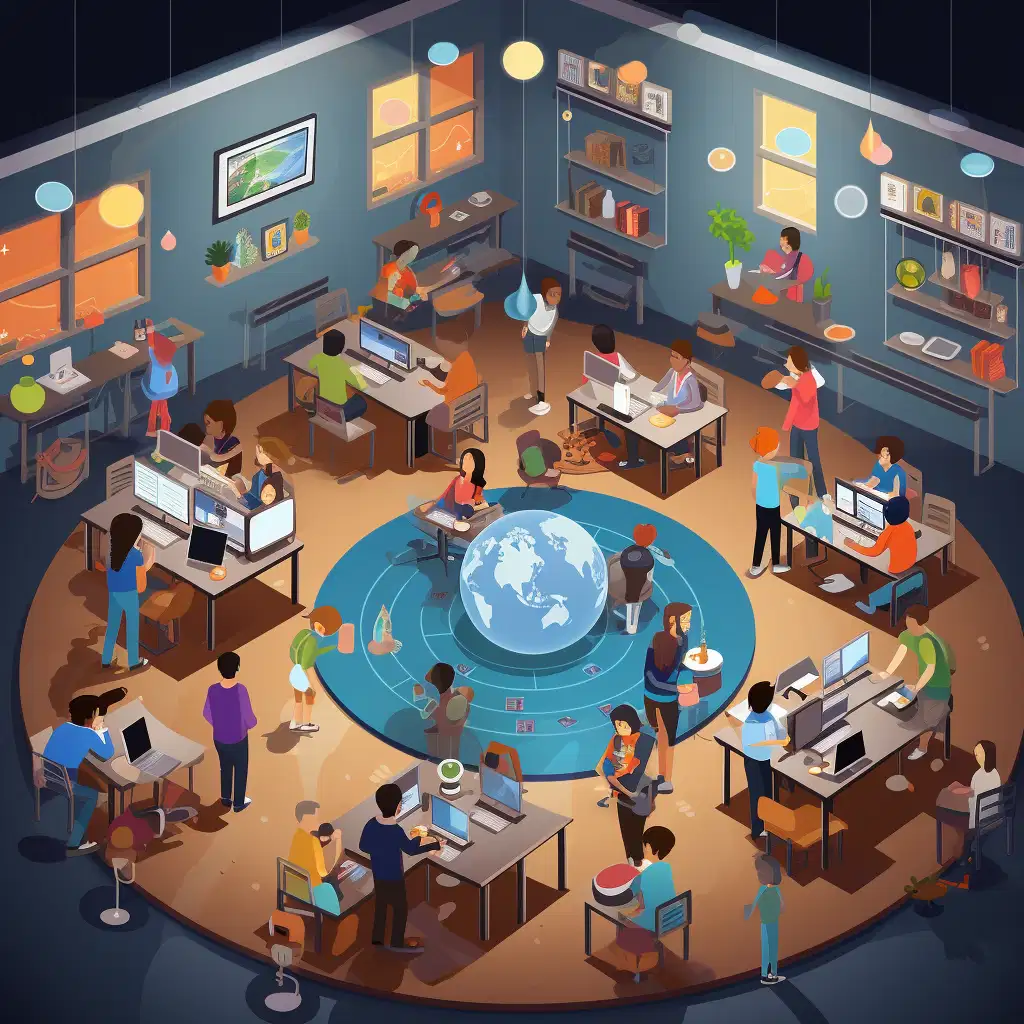
With interactive learning, assessment strategies also undertake a dynamic renovation. Formative assessments using online quizzes, interactive assignments, and game-based tasks give a clear insight into student progress and offer immediate feedback, which inspires seamless and ongoing learning.
Formative Assessments in Digital Learning Space
Using online quizzes, interactive assignments, and game-based tasks, formative assessments in an interactive learning environment provide quick insights into student strengths and areas for improvement. It gives teachers a perfect opportunity to provide immediate and constructive feedback.
Real-time Evaluation and Feedback
The ability to provide instant feedback is one of the significant benefits of interactive learning. Students can understand the mistakes they're making in real-time and course correct immediately, improving their overall learning process.
Seamless Learning Through Continuous Assessment
In interactive learning, assessments aren't restricted to the end of a unit or term. They are spread evenly throughout the learning period, ensuring a continuous learning process that leads to a better understanding and application of concepts.
Immersion and Gamification in Learning
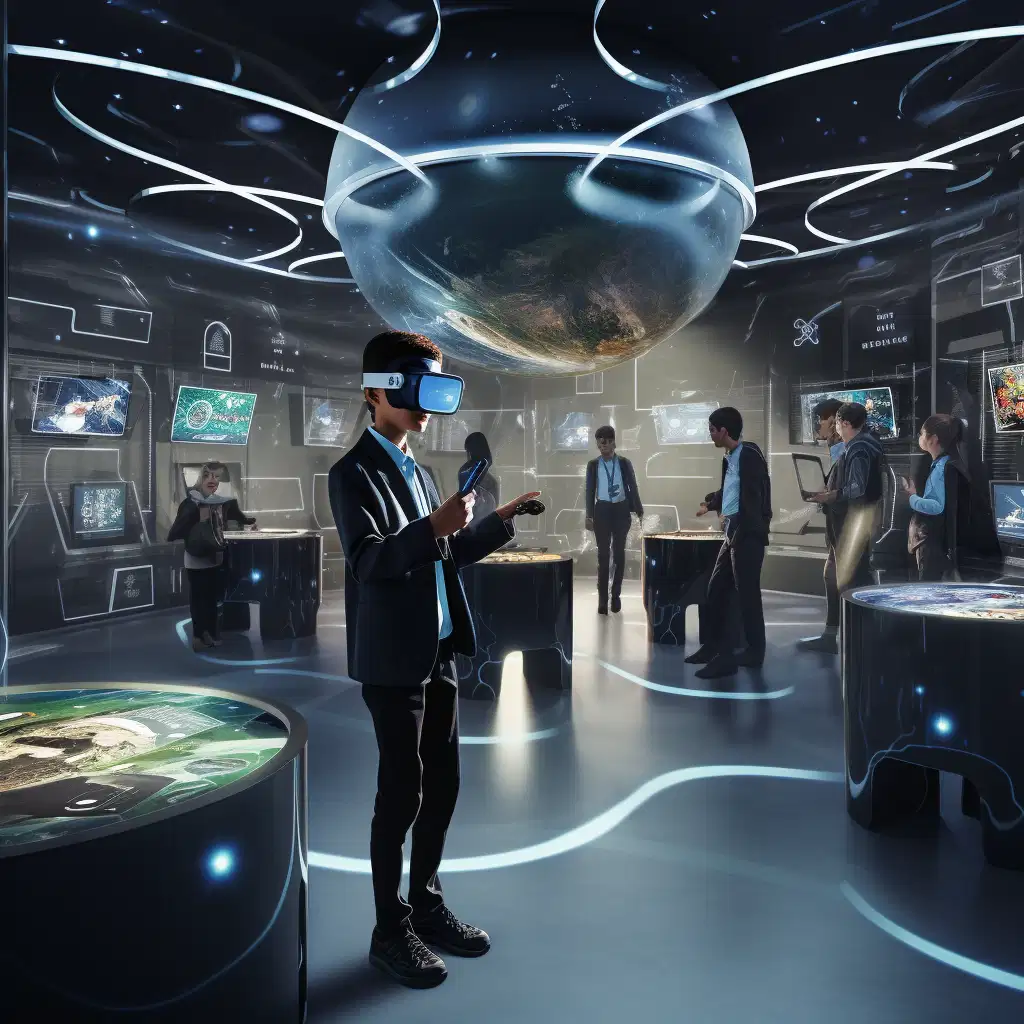
Immersive learning is achieved by applying advanced technologies like Virtual Reality (VR) and Augmented Reality (AR). This exciting learning experience takes students on a virtual journey and allows them to gain hands-on experiences while making learning engaging and productive.
In parallel, gamification helps make education more fun by incorporating gaming elements into learning, enhancing student enthusiasm and success.
Venturing into Immersive Learning
Immersive learning creates virtual scenarios that students can explore. Aided by virtual and augmented reality, this form of learning provides valuable hands-on experiences and ignites a flair of creativity and innovation among learners, making education more engaging.
The Thrill of Gamified Learning
Gamification in education offers an appealing approach to learning by incorporating game principles into educational activities. Some interactive learning systems even offer badges, points, and other incentives that foster a sense of accomplishment, making the process rewarding for learners.
Maximizing Learner Engagement
Immersion and gamification increase learner engagement by transforming education from a passive to an active, interactive experience. Through virtual scenarios or game tasks, students learn by doing, which can boost their motivation and deepen their understanding of the subject matter.
Immersive and gamified learning - where the boundary between play and education merges, fostering an engaging learning experience that stirs curiosity, fuels creativity, and hones intellect.
Knowledge Management in the Age of Interactive Learning
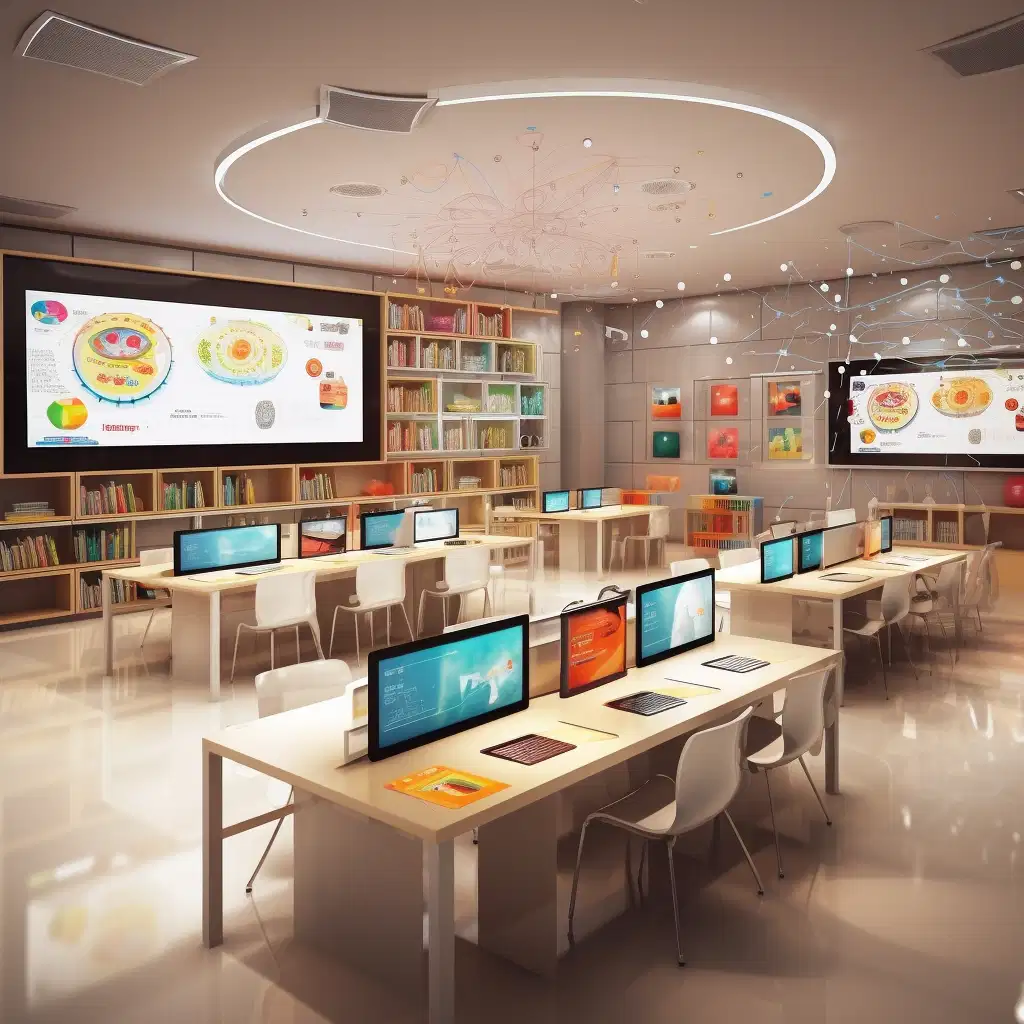
Interactive learning revolutionizes knowledge management in classrooms. It encourages students to take charge, research independently, think critically, and solve problems proactively, thus ensuring that knowledge is received, constructed, examined, and dynamically applied.
Transforming Knowledge Absorption
Emphasis on active construction, exploration, and application of knowledge breaks the monotony of traditional passive information receiving. Interactive learning breathes life into classroom learning experiences, pushing students to own their learning journey and drive it forward.
Igniting Self-motivated Learning
Interactive learning encourages a degree of 'self-learning,' where students actively seek knowledge driven by curiosity. This method strengthens students' abilities to independently research, organize their thoughts, think critically, and solve problems – skills beyond academics.
Leveraging Feedback in Knowledge Management
Feedback plays a crucial role in the interactive learning model. It helps learners recognize their strengths and identify areas needing improvement. Receiving regular, constructive feedback allows students to realign their learning strategies and fuels continuous knowledge improvement.
In conclusion, interactive learning is an intricate blend of traditional teaching techniques and cutting-edge technology. It's an exciting approach to education that promotes active participation, metacognitive skills development, engagement, and improved knowledge retention. With many online platforms, adaptive learning solutions, and gamified models, interactive learning offers a promising paradigm shift toward a more student-centric and dynamic educational future.
References
1. Anderson, L. W., & Krathwohl, D. R. (Eds.). (2001). A Taxonomy for Learning, Teaching, and Assessing: A revision of Bloom's taxonomy of educational objectives. Longman.
2. Bonwell, C. C., & Eison, J. A. (1991). Active learning: Creating excitement in the classroom (1991 ASHE-ERIC Higher Education Reports). George Washington University.
3. Hughes, J. (2004). Technology Learning Principles for Preservice and In-service Teacher Education. Contemporary Issues in Technology and Teacher Education, 4(3).
4. Kolb, A. Y., & Kolb, D. A. (2005). Learning Styles and Learning Spaces: Enhancing Experiential Learning in Higher Education. Academy of Management Learning & Education, 4(2), 193–212.
5. Prensky, M. (2001). Digital natives, digital immigrants Part 1. On the Horizon, 9(5), 1-6.
6. Klopfer, E., Osterweil, S., Groff, J., & Haas, J. (2009). We are using the technology of today in the classroom today.
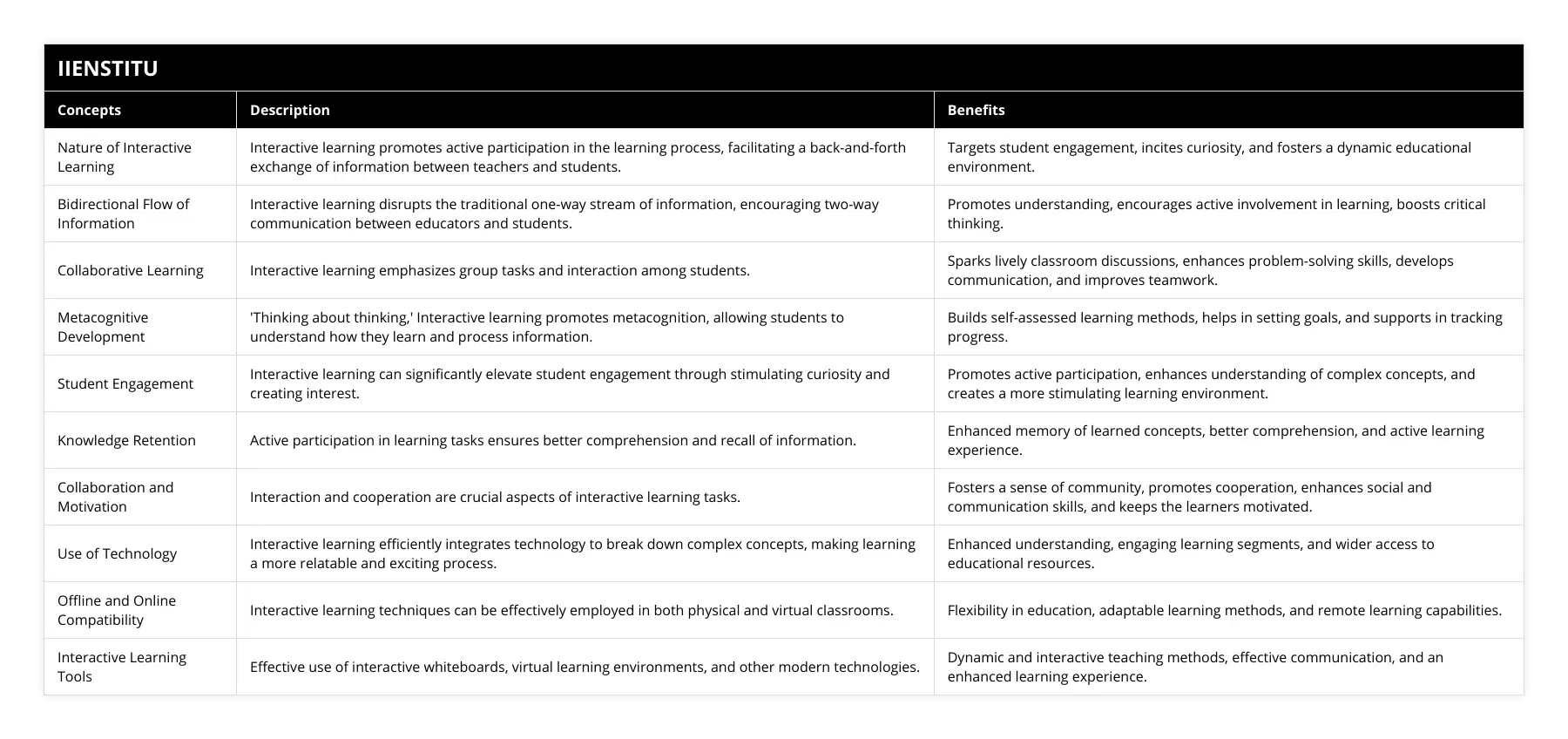
Frequently Asked Questions
What are the key factors that contribute to climate change?
Key Factors Contributing to Climate Change
There are several key factors that contribute significantly to climate change. The most significant is the burning of fossil fuels such as coal, oil and natural gas. When fossil fuels are burned, they release greenhouse gases like carbon dioxide and methane into the atmosphere. These greenhouse gases trap heat from the sun, causing global temperatures to rise.
Deforestation is another major factor. Trees absorb and store carbon dioxide. When forests are cleared, that stored carbon is released. Deforestation also reduces the number of trees available to remove carbon dioxide from the air. Between 2015 and 2020, the world lost over 4 million hectares of forest per year.
Intensive livestock farming generates significant greenhouse gas emissions. Cows and sheep produce methane as part of their digestive process. Large scale cattle ranching leads to deforestation too. The livestock sector accounts for around 15% of global emissions.
Other contributors are fertilizers containing nitrogen and the burning of biomass. Overall, human activities are responsible for almost all of the increase in greenhouse gases over the last century. To mitigate climate change, we must transition from fossil fuels to renewable energy and prevent further deforestation. We must also reduce emissions from agriculture and other sources.
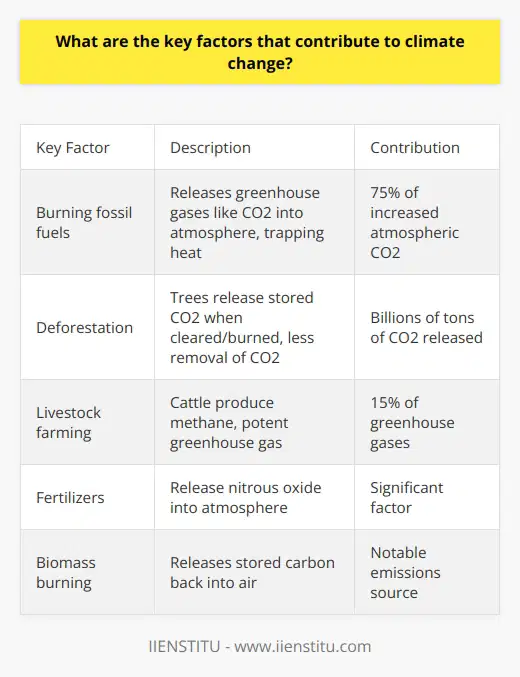
How does gender inequality manifest in different cultures?
Manifestations of Gender Inequality
Gender inequality refers to unequal treatment or perceptions of individuals based on their gender. This manifests in various ways across cultures. In many cultures, traditional gender roles cast women as caregivers and men as leaders. This leads to inequalities in domestic duties, employment, and positions of authority. For example, in parts of South Asia, women spend much more time on unpaid domestic work than men. In Saudi Arabia, strict laws prohibit women from traveling or working without a male guardian's permission.
Gender discrimination in education also perpetuates inequality. In Afghanistan, girls face barriers to attending school including lack of facilities, child marriage, and Taliban restrictions. Only 37% of Afghan girls complete primary education, compared to 66% of boys. This lack of education limits women's ability to participate in society.
Violence against women is another manifestation of gender inequality. Practices like female genital mutilation in parts of Africa, acid attacks in Southeast Asia, and honor killings in the Middle East target and control women. Up to 38% of murders of women worldwide are committed by intimate partners. Laws and enforcement often fail to protect women.
While many cultures have embedded gender inequalities, increased education for women and girls, activism, and legal protections are working to promote equal rights. Achieving gender equality requires changing long-held biases and practices.

What policies can governments implement to reduce poverty?
Policies to Reduce Poverty
Governments can implement several policies to help reduce poverty. One important policy is to increase access to education. Governments can make primary and secondary education free and compulsory. They can also provide subsidies and scholarships to help low-income students attend college or vocational schools. Education gives people the skills needed to obtain better-paying jobs.
Another policy is to create more jobs and improve wages. Governments can invest in infrastructure and green technology to create construction and manufacturing jobs. They can set higher minimum wages and strengthen unions to improve pay. Policies that support small businesses can also lead to more job creation.
Governments can also strengthen social safety net programs. They can provide cash assistance, food stamps, and housing vouchers to help families meet their basic needs. Healthcare subsidies can make insurance more affordable. Increasing funding for childcare, disability, and unemployment benefits further aids those struggling financially.
Lastly, governments can reform tax policies to ease the burden on lower-income households. They can make tax systems more progressive by increasing taxes on the wealthy. Tax credits like the Earned Income Tax Credit can supplement wages for workers. Reducing regressive payroll and sales taxes helps increase take-home pay.
Implementing a mix of education, job creation, safety net, and tax reform policies can significantly reduce poverty. A comprehensive approach addresses both the symptoms and root causes of financial hardship for low-income families and individuals.

What types of interactive activities can be used to engage students in the classroom?
Engaging Students through Interactive Activities
Teachers can use various interactive activities to get students involved in lessons. These activities make learning more enjoyable and help students retain information. Some useful interactive methods are described below.
Discussions
Class discussions allow students to share ideas and learn from each other. The teacher poses questions about the lesson and students respond. Peers can also question each other. Discussions help students develop critical thinking as they articulate and defend their views. They learn to listen respectfully to different opinions.
Games
Educational games add fun competition to reviewing material. Games like Jeopardy and Kahoot allow teams to answer questions. Games encourage participation from all students. Students are motivated to recall information to help their team score points. Games can be adapted for various subjects and age groups.
Simulations
Simulations immerse students in real-world scenarios. For example, a mock trial for a history lesson or a lab experiment on pollution. Simulations give a hands-on learning experience. Students apply knowledge instead of just memorizing facts. These activities boost engagement and show how classroom concepts connect to the real world.
Debates
Debates teach research, public speaking, and persuasive skills. Students are assigned a topic and point of view to defend before the class. Each side presents arguments and provides evidence to support their position. Debates encourage critical analysis as students articulate pros and cons on an issue. They learn to think on their feet and actively listen to rebuttals.
Peer Instruction
Peer instruction has students explain concepts to one another. The teacher presents a problem and asks students to discuss it with a partner. Then pairs share solutions with the class. Explaining ideas to peers improves understanding. It also builds communication skills. Peer instruction gives quiet students a chance to open up in a low-pressure environment.
In summary, discussions, games, simulations, debates, and peer instruction represent interactive techniques to engage students. These activities make learning participatory and enjoyable. They help students become active, confident learners.

How can interactive activities be used to promote critical thinking skills?
Using Interactive Activities to Promote Critical Thinking
Interactive activities can be highly effective tools for developing critical thinking skills in students. Critical thinking involves the ability to analyze information objectively, challenge assumptions, identify relationships between ideas, evaluate arguments, and draw conclusions based on evidence. Incorporating interactive elements into learning activities provides opportunities for students to practice and strengthen these skills.
Discussion and Debate
Classroom discussions and debates encourage students to articulate and defend their viewpoints. As they listen to others' perspectives, they learn to think flexibly and consider alternative ideas. Moderated effectively, these verbal interactions stimulate analytical reasoning as students support their claims with logic and evidence.
Collaborative Projects
When students work together on projects, they must evaluate each other's contributions, negotiate roles, and synthesize diverse ideas. The social dynamics inherent in collaboration compel students to sharpen their critical thinking abilities. Teachers can structure collaborative work to maximize opportunities for analysis, reflection and decision-making.
Problem-Solving Activities
Open-ended problems with multiple potential solutions encourage analytical thinking as students weigh options, analyze data, and justify their choices. Developing and testing solutions involves creativity, evaluation of alternatives, and consideration of consequences. Real-world simulations and case studies provide relevant contexts for practicing critical analysis.
Reflective Writing
Writing activities that require personal reflection - such as journals, blogs, and reaction papers - stimulate self-analysis and metacognition. As students articulate connections between new concepts and prior knowledge, they develop more conscious critical thinking strategies. Prompting students to examine their own thinking processes enhances cognitive skills.
By intentionally incorporating interactive elements into learning activities, educators can create opportunities for students to strengthen their skills in analysis, evaluation, inference, and other facets of critical thinking. When thoughtfully implemented, these activities can have a profound impact on students' intellectual development.

In what ways can interactive activities encourage collaboration and teamwork among students?
Encouraging Collaboration and Teamwork through Interactive Activities
Interactive activities provide valuable opportunities for students to collaborate, communicate, and build teamwork skills. When students work together on interactive projects, they learn to share ideas, divide responsibilities, and combine their strengths to achieve common goals. Several types of interactive activities are particularly effective for encouraging collaboration and teamwork.
Group games and simulations foster teamwork by giving students a common challenge to overcome. Educational games with team components, such as quiz bowls or scavenger hunts, promote collaboration by requiring students to pool their knowledge. Role-playing exercises and simulations, like mock trials or model UN debates, teach compromise, leadership, and group decision-making. These activities motivate students to work together creatively in pursuit of a shared objective.
Cooperative learning activities maximize participation and idea exchange. Structured small-group discussions, peer tutoring programs, and collaborative writing projects give every student a voice while necessitating cooperation. Dividing students into groups with diverse skillsets encourages inclusion and values diverse perspectives. Establishing shared goals and individual accountability further motivates students to collaborate effectively.
Interactive technology can facilitate valuable teamwork experiences online or in-person. Online discussion forums, chat tools, and collaborative editing software empower students to work together on projects even when physically separated. In the classroom, using interactive whiteboards, student response systems, or group laptops fosters real-time collaboration. By embracing interactive technology, instructors can provide new opportunities for cooperation and communication.
Interactive learning activities teach students the teamwork skills needed to thrive in school and beyond. When students collaborate, they learn to appreciate diversity, resolve conflicts, and build consensus. Group interactive learning prepares students to cooperate effectively in future educational endeavors, careers, and civic life. By promoting teamwork, interactive activities cultivate essential life skills.
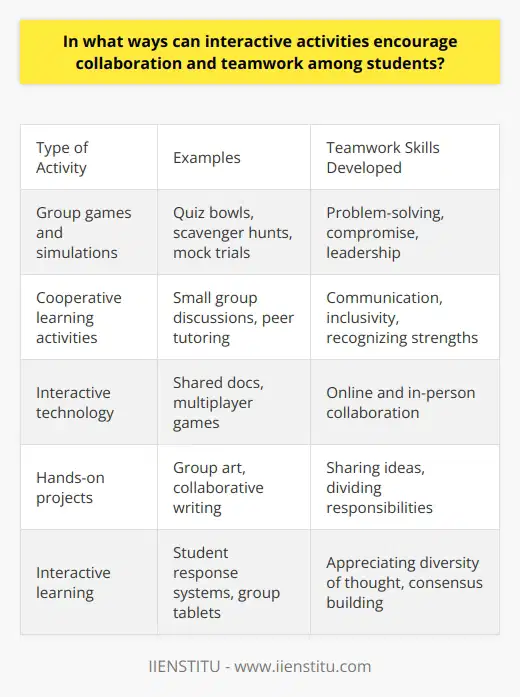
What are some examples of interactive learning being an exciting way to learn?
Interactive Learning as an Exciting Approach
Interactive learning provides students with engaging and dynamic ways to acquire knowledge and skills. This approach moves away from passive listening and note-taking and instead emphasizes active participation, collaboration, and experiential learning. There are many examples of interactive techniques that create excitement around learning.
Hands-On Activities
Letting students get hands-on with concepts is an exciting way to drive learning. Science labs that allow students to conduct experiments and see chemical reactions unfold make science come alive. Manipulating numbers and variables in math reinforces concepts. Roleplaying historical events or literary scenes brings them to life. Making physical models and prototypes teaches design thinking. These tactile activities stick in students' minds.
Interactive Games
Educational games introduce fun competition while reviewing material. Trivia games like Kahoot allow students to answer questions using their devices. Active video games get students moving while learning. Board games that simulate real-world systems teach through experience. Puzzles reinforce critical thinking skills. Games provide instant feedback and gratification that motivate students to keep learning.
Discussions
Discussing material in pairs or groups requires students to articulate and defend their knowledge. Hearing peers' viewpoints introduces new perspectives. Debates encourage research and analysis to support arguments. Student-led discussions empower students to take charge of their learning. The social dynamics make discussions engaging. They also build vital interpersonal skills.
Digital Interactivity
Interactive technology tools boost engagement. Clickable images, videos, and animations immerse students in material. Adaptive programs adjust to students' levels and needs. Customizable online manipulatives like virtual math blocks make abstract concepts tactile. Web quests take students on guided learning adventures. Augmented and virtual reality transport students into immersive worlds. These digital experiences captivate and educate.
Interactive learning provides memorable, engaging experiences that get students excited about learning. Students are active participants rather than passive observers. These techniques stick with students long after the lesson is over and foster enthusiasm for continued learning.
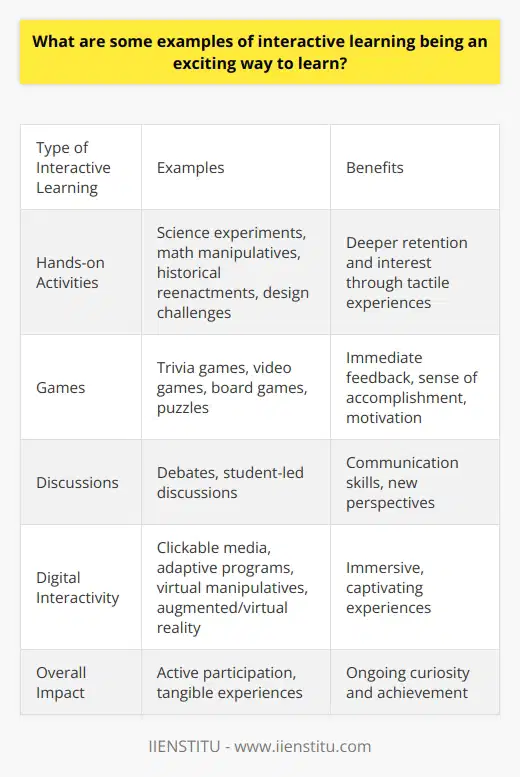
How can interactive learning provide exciting and engaging examples for students?
Benefits of Interactive LearningInteractive learning provides students with exciting and engaging examples through various techniques that promote active participation. This type of learning moves away from passive listening and note-taking to encourage deeper understanding and retention. Some key benefits of interactive learning are increased motivation, improved critical thinking, and real-world application.
Increased Motivation Interactive learning boosts student motivation in several ways. First, it caters to different learning styles like visual, auditory, and kinesthetic. Varied activities like games, discussions, and hands-on projects appeal to students' interests and preferences. This diversity makes learning more enjoyable and inspiring. Additionally, interactive techniques provide a sense of control over one's own education. Students can direct inquiries, choose group roles, and lead presentations. This autonomy and responsibility result in greater enthusiasm and engagement.
Improved Critical ThinkingInteractive learning develops critical thinking skills by moving students to higher-order cognitive tasks. Instead of just absorbing information, students must actively apply, analyze, and evaluate concepts. Activities like case studies, debates, and peer teaching force learners to synthesize information and form independent viewpoints. This process requires depth of thought and consideration of multiple perspectives. Students learn how to think rather than what to think.
Real-World Application Interactive learning connects course material to real life through authentic examples and hands-on scenarios. For instance, business students could role-play client meetings, science students could conduct experiments, and history students could reenact important events. These experiences help cement abstract ideas by showing how academic concepts work in practice. Students learn skills directly applicable to future careers and daily life. The relevance keeps students engaged and invested in their education.
In summary, interactive techniques like discussions, simulations, and group work provide exciting and engaging learning experiences. They boost student motivation, develop critical thinking, and promote real-world application of knowledge. By actively involving learners, interactive education creates meaningful and memorable lessons.
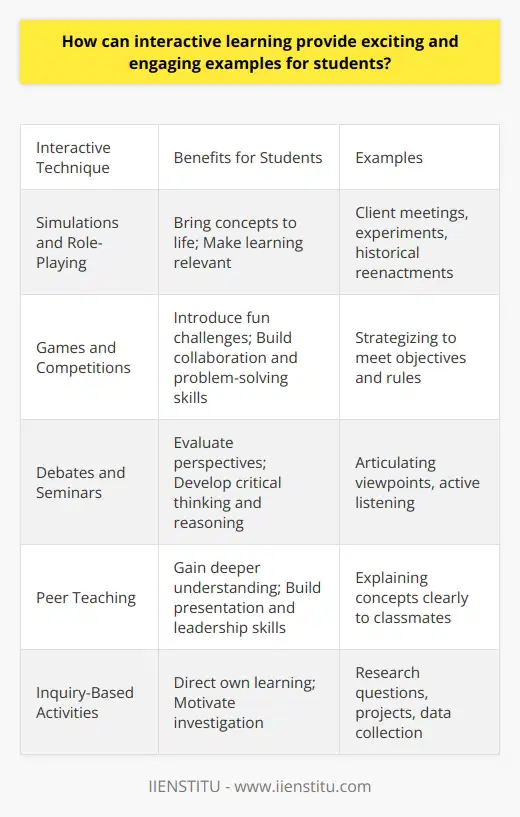
In what ways can interactive learning promote excitement and engagement through learning examples?
Promoting Excitement and Engagement through Interactive Learning
Interactive learning techniques can greatly increase excitement and engagement in the classroom. By incorporating active participation and prompt feedback, students become more invested in the material. Several methods of interactive learning have proven effective for boosting enthusiasm.
Discussions and Debates
Holding discussions and debates on course topics gets students actively involved. When students defend their perspectives, they engage more critically with the content. Structured small group discussions give quieter students a chance to find their voice. Debates encourage research and let students take an active role. These techniques give students ownership over their learning.
Games and Simulations
Educational games and simulations draw students into learning by being fun and competitive. Kahoot, quiz bowl, Jeopardy, and other quiz games introduce content in an exciting way. Role-playing and simulation activities let students apply course concepts in immersive settings. These activities feel more like play than traditional schoolwork, so they reduce boredom in the classroom.
Peer Instruction
Peer instruction methods leverage students’ desire to interact with classmates. Think-pair-share activities, for example, have students reflect individually, discuss with a partner, and then share ideas with the class. This interactive process keeps students engaged. Peer tutoring and student-led review sessions also enable learning by allowing students to teach each other.
Technology Integration
Digital tools can facilitate interactive learning experiences. Clickers, online quizzes, discussion boards, and interactive presentations give students opportunities to participate. These technologies provide instant feedback to keep students focused. Additionally, online simulations, games, and virtual environments immerse students in active learning worlds. Integrating technology sparks excitement through novelty.
Overall, interactive techniques promote engaged learning by giving students agency over the material. Active participation in applying concepts leads to deeper retention and interest. Leveraging discussion, games, peer-to-peer activities, and technology tools can bring energy and enthusiasm to any classroom.

What are some of the benefits of interactive learning as a method of engaging students?
Active Learning Promotes EngagementInteractive learning methods actively engage students in the learning process rather than having them passively receive information. This promotes increased attention, motivation, and interest. Interactive techniques like discussions, games, simulations, and experiments require students to participate. This active involvement means students are more focused and retain information better. Develops Communication and Collaboration Many interactive methods are collaborative, requiring students to communicate and work together. Group projects, discussions, and peer learning activities develop interpersonal skills. Students learn to articulate ideas, listen to others, provide constructive feedback, and resolve conflicts. Collaborative learning also allows students to teach and learn from each other.Appeals to Different Learning StylesPeople have different learning styles. Some are visual learners while others prefer to learn by doing. Lectures appeal mainly to auditory learners. Interactive methods incorporate visual, auditory, reading/writing, and kinesthetic learning. This variety engages students of all learning styles. Games, simulations, experiments, art activities, and roleplays actively involve students in the learning process.Promotes Critical ThinkingInteractive learning encourages students to apply critical thinking skills. Activities like case studies, debates, projects, and open-ended questions require analysis, evaluation, and creation rather than just memorization. Students learn how to synthesize information, weigh pros and cons, think logically, and justify conclusions. Developing these higher-order thinking skills prepares students for real world problem solving.Provides Immediate FeedbackInteractive learning offers ongoing assessment. Through discussions, activities, and group work, instructors can immediately gauge student understanding. This allows them to provide specific feedback and clarify concepts while students are learning. Instant feedback also helps students improve comprehension and self-evaluate their progress. This promotes metacognition as students reflect on their own learning.Increases Student Satisfaction Research shows interactive techniques lead to greater student satisfaction and perceived learning gains. Students enjoy active learning more than passive lectures. They also feel more confident in their abilities when they can apply and demonstrate knowledge through interactive tasks. This leads to greater motivation and engagement, creating a positive cycle.In summary, interactive learning provides numerous benefits over traditional lectures. It promotes active engagement, develops collaboration skills, appeals to different learning styles, encourages critical thinking, provides instant feedback, and increases student satisfaction. Incorporating interactive methods is an effective way to actively involve students in the learning process.
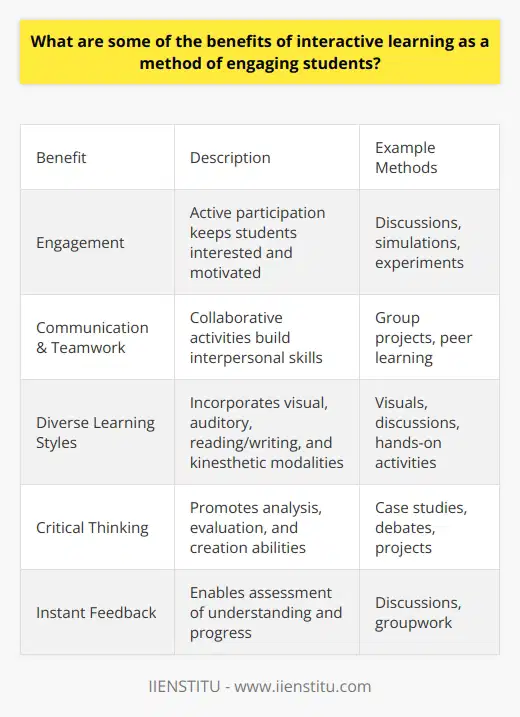
How can interactive learning techniques help students retain information and find meaning in course content?
Engaging Students Through Interactive Learning
Incorporating interactive learning techniques into the classroom can be an effective way to help students retain information and find meaning in course content. Interactive learning moves away from passive listening and note-taking to actively engage students in the learning process. According to research, active participation enhances understanding, long-term retention, and problem-solving skills (Bonwell, 1991). There are various methods instructors can utilize to promote interactive learning.
Discussions and Debates
Holding small group or whole class discussions and debates around course topics requires students to critically think through concepts and articulate their knowledge. When students verbally express their ideas, analyze differing viewpoints, and respond to others, they gain deeper comprehension of the material (McKeachie, 2002). Additionally, the social nature of discussions makes learning more enjoyable and impactful.
Experiential Activities
Experiential learning activities, such as simulations, experiments, and field work, allow students to actively apply their knowledge and skills. For example, business students may analyze a case study and propose solutions. The hands-on nature of experiential activities not only reinforces classroom lessons, but also allows students to practice skills needed for their future careers (Kolb, 1984). These activities make course content come alive.
Peer Learning
Peer learning techniques, like think-pair-share and peer tutoring, leverage student collaboration to stimulate engagement. Explaining concepts to peers reinforces students’ own understanding of the material. Additionally, teaching and guiding others provides validation and boosts confidence. Through peer learning, students take ownership of their education and learn from each other (Boud, 2001).
In summary, interactive techniques like discussions, experiential activities, and peer learning provide students with opportunities to actively process information and make meaningful connections. This results in improved content retention, skill building, and student empowerment. Instructors should incorporate interactive methods to create dynamic learning environments where students are motivated participants, not passive observers.
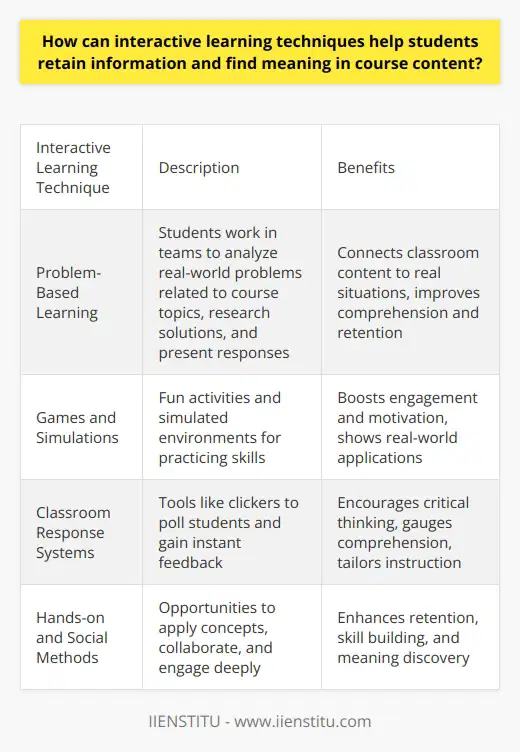
In what ways does interactive learning provide an exciting alternative to traditional lecture-based instruction?
Benefits of Interactive LearningInteractive learning provides an exciting alternative to traditional lecture-based instruction in several key ways. First, interactive learning promotes active student engagement rather than passive listening. With techniques like think-pair-share, small group discussions, debates, and hands-on activities, students participate more actively in the learning process. This type of constructive learning leads to deeper understanding and retention of course material.
Second, interactive learning facilitates the development of critical thinking, communication, and teamwork skills. Through collaborative exercises like project-based learning, students learn how to solve problems creatively, express ideas clearly, and work together productively. These skills better prepare students for the demands of the modern workplace.
Increased Motivation and EnjoymentAdditionally, interactive learning is more enjoyable for students, leading to increased motivation. Varied activities like games, simulations, and role-playing break up the monotony of continuous lecturing. When students are engaged and having fun, they are more intrinsically motivated to learn. This motivation drives deeper learning.
Finally, interactive learning caters to diverse learning styles. While lectures appeal mainly to auditory learners, interactive activities provide kinesthetic, visual, social, and other modalities. Accommodating different learning styles ensures a more equitable and accessible learning experience. Overall, the research clearly shows interactive learning promotes engagement, critical thinking, motivation and enjoyment of learning for students.

What are some effective interactive learning examples that can be used in the classroom?
Active Learning Strategies
Think-Pair-Share
Classroom Debates
Educational Games
Hands-on Learning
Conclusion
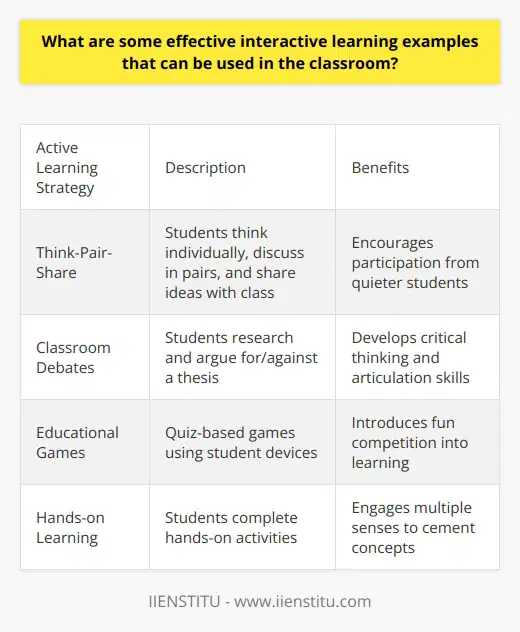
How can interactive learning examples improve student engagement and comprehension of course material?
Interactive Learning Improves Engagement and Comprehension
Interactive learning techniques, such as simulations, games, and discussions, can greatly improve student engagement with course material. When students are actively involved in the learning process, they are more likely to pay attention, retain information, and comprehend key concepts. There are several reasons why interactive learning is effective for boosting engagement and comprehension.
Active Learning
Interactive learning turns students into active participants rather than passive listeners. Actively applying knowledge through discussions, games, or simulations creates meaningful learning experiences. Students engage more when they can interact, experiment, and solve problems. This hands-on learning sticks better than just listening to lectures.
Instant Feedback
Interactive learning often provides instant feedback to students, allowing them to evaluate their own understanding. Online quizzes, discussions, and activities let students test their knowledge right away. This feedback helps identify comprehension gaps quickly so students can get clarification.
Improved Motivation
The interactive and social aspects of these teaching techniques boost student motivation and interest in the material. Games, discussions, and simulations are fun and engaging ways to learn. This increased enjoyment and motivation to participate leads to better comprehension and retention.
Appeals to Different Learning Styles
People have a variety of preferred learning styles. Interactive learning allows instructors to appeal to visual, auditory, reading/writing, and kinesthetic learners. Using a mix of games, multimedia, discussion, and hands-on activities engages students across learning styles. This expanded engagement leads to higher comprehension.
In summary, interactive learning methods like simulations, discussions, and games offer many benefits for student engagement and comprehension. The active, social, and enjoyable aspects of these techniques create meaningful learning experiences that stick with students better than traditional lectures. Utilizing interactive learning is an effective way to boost student success.

In what ways can interactive learning examples be incorporated into lesson plans to optimize student learning outcomes?
Benefits of Interactive LearningInteractive learning techniques provide numerous benefits for optimizing student learning outcomes. When students are actively engaged in the learning process, they gain a deeper understanding of the material. Interactive learning also caters to different learning styles, as hands-on activities, discussions, simulations, and other techniques appeal to visual, auditory, and kinesthetic learners. Furthermore, interactive learning promotes collaboration, critical thinking, and problem-solving skills.
Types of Interactive Learning ActivitiesThere are many types of interactive learning activities that can be incorporated into lesson plans across all subjects and grade levels. These include think-pair-share discussions, jigsaw activities, debates, role playing, games, simulations, experiments, design challenges, peer teaching, and stations with different hands-on tasks. Teachers can also leverage technology through interactive presentations, educational videos, online games, virtual simulations, and discussion boards. Field trips to interactive museums or sites also provide immersive learning experiences.
Implementation StrategiesWhen implementing interactive learning, teachers should clearly explain activities and expectations, group students purposefully, set time limits, and facilitate engagement. Teachers should also integrate reflection after activities to consolidate learning. Furthermore, interactive learning works best when incorporated regularly, not just occasionally. Starting lessons with short interactive warm-ups, building multiple activities into each lesson, and supplementing lectures with hands-on application are effective strategies.
AssessmentInteractive learning enables alternative assessment techniques such as observing students during activities, evaluating hands-on products and presentations, and analyzing discussion contributions. These authentic assessments allow teachers to gain deeper insights into student learning. Teachers can also incorporate interactive elements into formal assessments like tests, having students annotate text passages or analyze data sets. Self and peer assessment can also reinforce learning.
In summary, interactive learning provides myriad techniques for optimizing student engagement and outcomes. By actively involving students in the learning process, teachers can increase understanding, accommodate different learning styles, build vital skills, and assess learning in authentic ways. Integrating interactive activities regularly using effective strategies will enhance any curriculum.
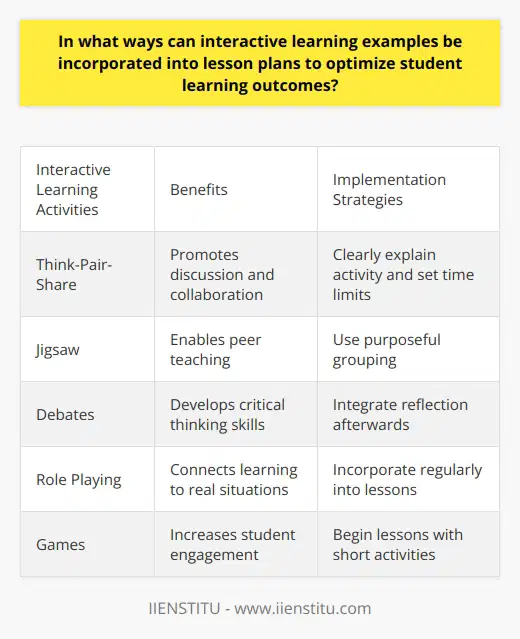
What are the benefits of interactive learning?
Active EngagementInteractive learning encourages active engagement from students. Rather than passively listening to lectures, interactive techniques like discussions, games, and simulations get learners to actively participate. This participation improves attention, motivation, and retention of material. Students who actively engage with content through activities like answering questions, explaining concepts, and solving problems gain a deeper understanding compared to passive listening.
Adaptive InstructionInteractive learning allows for adaptive instruction tailored to each student's needs. With techniques like personalized assignments, one-on-one mentoring, and adaptive software, instruction can be adjusted based on individual learner's strengths, weaknesses, interests, and progress. This personalization caters to different learning styles and paces. Adaptive instruction ensures students are supported and challenged at their own level.
Immediate Feedback Interactive learning provides opportunities for immediate feedback. Through discussions, games, and online activities, students can get real-time feedback on their performance. This allows them to identify areas of weakness and make corrections right away. Immediate feedback improves learning outcomes as students can adjust their approach before incorrect understandings are cemented. This feedback loop is more beneficial than traditional tests which provide delayed feedback.
Improved Communication SkillsInteractive learning develops strong communication skills. Through collaborative work, discussions, presentations, and questioning, students must organize thoughts, articulate ideas, listen actively, and respond appropriately. These activities build essential interpersonal and communication competencies. Students learn how to communicate concepts clearly, tailor messages to audiences, provide constructive feedback, and resolve conflicts.
Increased Motivation and EngagementInteractive techniques are inherently more engaging and motivating than passive learning. Learners are stimulated through activities, challenges, and peer collaboration. This increased engagement results in greater time on task and persistence. Interactive learning keeps students interested and participating actively rather than tuning out during lectures. Students take greater ownership over their learning and are intrinsically motivated to succeed. This motivation translates to better academic performance.
How does interactive learning improve student engagement?
Interactive Learning Increases Student ParticipationInteractive learning provides opportunities for students to actively participate in lessons rather than passively receive information. This participation keeps students engaged and focused. Interactive techniques like think-pair-share, small group discussions, debates, and hands-on activities require students to verbally express their ideas and collaborate with peers. This active participation improves attentiveness and information retention compared to traditional lecture formats where students listen passively.
Interactive Learning Accommodates Different Learning StylesPeople have different preferred learning styles. Some students learn best visually, others through auditory means, and others through hands-on activities. Lectures tend to focus on auditory learning, which does not meet the needs of visual and tactile learners. Interactive learning incorporates visual aids, group discussions, and physical activities to accommodate visual, auditory, and kinesthetic learning styles. Providing diverse interactive experiences allows more students to engage through their preferred learning methods.
Interactive Learning Allows Customization Interactive learning is adaptable to students' specific needs and interests. Teachers can customize interactive lessons to focus on topics that resonate most with their students. Students can also make choices during interactive activities, like selecting their own discussion topics, that align with their curiosities and motivations. This flexibility and autonomy increases students' interest and willingness to participate. Customized interactive learning feels more relevant than one-size-fits-all lectures.
Interactive Learning Provides Instant FeedbackDuring interactive learning, teachers can provide real-time feedback and gauge student comprehension. Teachers can circulate during group activities to check-in with individual students. Interactive technology like classroom response systems also allow teachers to get instant feedback on which concepts students grasp and which need more explanation. This immediate feedback enables teachers to clarify misunderstandings on the spot before moving forward. Instant feedback keeps students engaged and supports deeper learning.
Interactive Learning Promotes Peer Connections Interactive activities provide opportunities for students to communicate and collaborate with their peers. Group discussions, projects, and peer reviews foster social connections between students. Building these interpersonal bonds increases students’ comfort levels in class and sense of belonging. Interactive learning feels more friendly and welcoming than sitting in isolation listening to a lecture. The social nature of interactive learning leads to greater participation and engagement.
In what ways can interactive learning be incorporated into the classroom?
Benefits of Interactive LearningInteractive learning provides numerous benefits for students. When students are actively engaged, they retain more information. Interactive learning also caters to different learning styles like visual, auditory, and kinesthetic. It allows students to take ownership of their education through problem-solving, discussions, and hands-on activities. This results in deeper understanding and improved critical thinking skills. Strategies for ImplementationThere are many simple ways teachers can incorporate interactive learning into their classrooms. One approach is to have students work in small groups or pairs. Collaborative exercises teach teamwork and communication skills. Teachers can also use games to review material in an engaging way. Many concepts can be taught through interactive simulations or role playing scenarios. Classroom response systems are another effective tool for getting instant feedback. Finally, discussions and debates encourage students to think critically and articulate their ideas. Technology IntegrationEducational technology greatly facilitates interactive learning. Students can watch instructional videos, engage with interactive whiteboards, and use computers or tablets for individualized learning. There are many educational websites, apps, and software programs with built-in interactivity. Teachers can monitor student progress in real-time and provide instant feedback. Social media and other Web 2.0 tools also allow for collaboration and information sharing. The key is choosing technology that aligns with curriculum goals and promotes active learning.Assessment It's important to assess interactive learning activities with rubrics tied to learning objectives. Students can demonstrate understanding through projects, presentations, writing assignments, and more. Self and peer review teaches reflection and gives students ownership over the assessment process. Exit tickets, classroom response system data, and other formative assessments help gauge student progress. The feedback provided during interactive learning is key to maximizing instructional impact. ConclusionInteractive techniques have proven benefits for student achievement and engagement. While they require more planning, the payoff can be immense. Teachers should incorporate a variety of interactive strategies to accommodate diverse learning styles. With sound implementation and assessment, interactive learning can profoundly impact students. The hands-on, student-centered approach promotes deep understanding and skills for the 21st century.
How can teachers promote interactive learning in the classroom
Encouraging Student ParticipationTeachers can promote interactive learning by encouraging student participation. They can ask open-ended questions that require more than a yes or no response. This gets students engaged in discussion. Teachers should call on different students, not just those with their hands up. They can use think-pair-share methods, where students think individually, pair up to discuss, then share ideas with the class. Games like quiz bowls make learning competitive and interactive. Group Work and Peer Learning Group work activities allow students to interact with peers. Teachers can create small groups and have students complete collaborative projects. This allows them to learn from each other. Peer learning can be facilitated by pairing students up to peer edit papers or solve math problems. Stronger students reinforce their own learning by explaining concepts to others. Group work enables interactive learning through discussion, task delegation, and teamwork.Debates and DiscussionsClassroom debates encourage student participation and critical thinking. Teachers can introduce controversial issues and have students take sides. Each team researches and prepares arguments to support their position. During the debate, they can point out flaws in the opposing team's arguments. Discussions also stimulate interactive learning by having students share perspectives on topics. The teacher acts as a facilitator, posing questions and guiding the discussion.Interactive Technology Technology tools boost interactive learning by getting students actively involved. Teachers can use clicker systems for real-time voting and polling during lessons. Interactive whiteboards allow students to come up and work through problems in front of the class. Game-based learning platforms provide interactive, competitive exercises. Virtual reality immerses students in simulated environments. These technologies facilitate active student participation and engagement.Experiential LearningHands-on learning experiences, like experiments, engage students interactively. Science teachers can have students conduct lab experiments in groups and record observations. Teachers may also bring students on interactive field trips to places like museums, farms, or historical sites. These experiential activities allow students to actively apply classroom lessons. Learning by doing through interactive experiments and field trips promotes retention.
What are some effective strategies for making lessons more interactive for students
Student Engagement Through Active LearningActive learning is a key component of creating an interactive and engaging classroom environment. Some effective active learning strategies include think-pair-share activities, debates, simulations, and gamification. Think-pair-share activities provide opportunities for students to discuss concepts in pairs or small groups before sharing ideas with the whole class. This allows all students to process information more thoroughly before being asked to contribute ideas publicly. Classroom debates encourage students to take and defend a position, thereby deepening their understanding of course material. Simulations and roleplaying exercises immerse students in real-world scenarios to apply their knowledge in a practical context. Gamification uses game elements like points, levels, and leaderboards to motivate participation and make learning more fun. Promoting Student Collaboration Collaborative learning activities leverage peer interactions to foster engagement. Group projects, peer tutoring, and jigsaw activities all enable students to learn from and support each other. Divide students into small groups and have them complete a task collectively, such as analyzing a case study or solving a problem. Peer tutoring programs allow students to teach and learn from fellow classmates under the guidance of the instructor. In jigsaw activities, each student becomes an "expert" on one topic and teaches it to their group members. These collaborative approaches promote teamwork and accountability while allowing students to learn from each other.Leveraging Technology and MultimediaIncorporating technology and multimedia into lessons can capture students' interest and promote interactivity. Online polls, quizzes, and surveys provide instant feedback on student understanding. Interactive whiteboards allow instructors to display engaging visuals, embed multimedia content, and collaborate with students in real-time. Educational apps and games present material in stimulating digital formats. Virtual reality field trips transport students to immersive environments beyond the classroom. Using a variety of technological tools and multimedia makes lessons more stimulating and relevant to tech-savvy learners.Fostering Student Choice and Autonomy Providing students with opportunities for choice and self-direction enhances their motivation and satisfaction. Open-ended assignments allow students to select paper topics reflecting their interests. Student-driven review sessions empower learners to identify and clarify challenging concepts. Classroom "genius bars" enable students to self-organize study groups to obtain peer support. Flexible seating arrangements give students the freedom to choose where they learn best. Incorporating choice into lessons helps students take ownership over their learning and makes the classroom experience more engaging.
What are the benefits of using interactive learning methods in the classroom?
Engagement through Active ParticipationInteractive learning methods encourage active participation from students, which leads to greater engagement with course material. When students are actively involved in lessons through discussions, collaborative projects, simulations, and other hands-on activities, they feel more invested in their own learning process. This boosts motivation, focus, and retention of information. Interactive methods provide opportunities for students to engage with content more deeply compared to passive listening.
Developing Communication and Collaboration Skills Many interactive methods are designed around group work, discussion, and sharing ideas. Working collaboratively gives students valuable practice communicating thoughts and working as a team. Developing these interpersonal skills better prepares students for the team environments found in most workplaces. The communication skills built through interactive learning also help improve students' confidence and ability to clearly articulate ideas.
Catering to Diverse Learning Styles People have a wide spectrum of learning styles. Some absorb information best through listening, others through visual aids, and still others through hands-on problem solving. Lectures alone appeal to auditory learners, but interactive methods can reach visual, tactile, and kinesthetic learners as well. The variety of interactive activities provides opportunities for students with different learning styles to excel. This diversity improves outcomes for a wider range of students.
Higher Order ThinkingInteractive learning often requires more complex thinking than just memorizing facts from a lecture. Through discussions, debates, experiments, and presentations, students utilize skills like analysis, synthesis, evaluation, and creation. Higher order thinking results in deeper learning and helps students apply and transfer knowledge to new contexts. The cognitive benefits of interactive methods prepare students for the critical thinking required in higher education and the modern workplace.
Immediate Feedback Interactive methods provide real-time feedback to both students and instructors. Discussions and activities reveal how well students grasp concepts, allowing instructors to immediately clarify any misunderstandings. Students also receive instant feedback from peers and instructors that helps them evaluate their own progress. This feedback loop enables quicker adjustments and improvements during the learning process.
What are the advantages and disadvantages of interactive teaching methods?
Advantages of Interactive Teaching MethodsInteractive teaching methods have several benefits compared to traditional lecture-based teaching. First, interactive methods promote active learning and student engagement. When students participate in discussions, activities, and group work, they engage more deeply with course material. This leads to improved understanding and retention. Second, interactive methods allow for differentiated instruction. Teachers can tailor activities to students' diverse learning styles, abilities, and interests. This personalization caters to students' needs. Third, interactive methods develop students' interpersonal skills. Communication, collaboration, and teamwork are practiced during group work and class discussions. These are valuable real-world skills.
Disadvantages of Interactive Teaching MethodsHowever, interactive methods also have some drawbacks. First, they require more preparation and effort from teachers. Developing activities and lessons that engage students is time-consuming. Second, interactive methods can be difficult to manage. With increased student participation comes potential for disruption and loss of control. Teachers must balance openness with maintaining order. Third, some students may resist interactive methods if they are used to only listening passively in class. It takes time for students to become comfortable with greater responsibility and autonomy.
In conclusion, interactive teaching methods have significant benefits for student learning and engagement. However, they also demand more from teachers in terms of preparation and classroom management. With proper implementation, interactive techniques can enhance students' knowledge, skills, and interests. But teachers must invest time and effort to ensure interactive methods are structured, focused, and suitable for their students.
How can teachers effectively utilize interactive teaching methods in the classroom?
Student Engagement Through Interactive MethodsTeachers can promote active learning and increase student engagement by utilizing interactive teaching techniques. Interactive methods require students to participate, think critically, and collaborate. This results in deeper learning compared to passive listening. Some effective interactive strategies include:Group Discussions Facilitating small group discussions encourages participation from students who may be reluctant to speak up in front of the whole class. Teachers can pose open-ended questions for groups to analyze together. This develops teamwork and communication skills.Think-Pair-ShareThe think-pair-share technique has students reflect individually, discuss ideas with a partner, and share thoughts with the class. This provides time for students to process concepts and articulate their knowledge. DebatesStructured debates build critical thinking as students research evidence to support their position. Friendly competition creates engagement. Debates teach argumentation skills.Peer Learning Peer learning activities, such as peer tutoring and peer review, enable students to teach and learn from one another. This allows students to take ownership of their education. GamesEducational games introduce fun competition into the classroom. Games reinforce learning objectives and motivate students to repeatedly practice skills. Technology IntegrationDigital tools, like polling apps and interactive whiteboards, facilitate interactive learning. Technology appeals to different learning styles and allows teachers to monitor student progress in real-time.Thoughtfully incorporating interactive techniques keeps students focused and involved in lessons. Students learn more effectively when they can apply concepts through discussion, collaboration, and hands-on activities. Interactive classrooms promote deep understanding and skills that benefit students well beyond the classroom.
In what ways can interactive teaching methods improve student engagement and learning outcomes?
Interactive Teaching Methods Enhance Student Engagement
Collaborative Activities Promote Teamwork Skills
Multimodal Instruction Accommodates Diverse Learning Styles
Immediate Feedback Improves Learning Outcomes
Conclusion
What are some effective interactive learning strategies for increasing student engagement?
Interactive Learning Strategies
There are various interactive learning strategies that can be utilized to increase student engagement in the classroom. Some effective techniques include think-pair-share activities, gamification, simulations, and technology integration. These methods provide opportunities for active student participation and collaboration which can enhance motivation and learning outcomes.
Think-Pair-Share
The think-pair-share strategy promotes critical thinking and discussion. First, students are given a question or problem to consider individually. Next, they pair up and share their ideas with a partner. Finally, pairs share their thoughts with the whole class. This technique allows all students to be actively involved and gets them communicating about academic concepts.
Gamification
Gamification applies game elements like points, levels, and badges to learning activities. This increases engagement by tapping into students' natural desires for competition, achievement, and status. Teachers can use gamification through online tools, apps, or by creating their own game-inspired classroom activities. It provides motivation through fun, interactive experiences.
Simulations
Educational simulations immerse students in realistic scenarios to practice decision making, critical thinking, and problem solving. There are simulations available online across all subject areas. Teachers can also create their own simple classroom simulations. This experiential learning engages students in higher-order application of knowledge.
Technology Integration
Integrating technology like computers, tablets, or interactive whiteboards can facilitate more active learning. Students can collaborate on group projects, create presentations, conduct online research, complete interactive learning exercises, and more. Educational apps and websites provide engaging content. Using technology aligns with students' digital interests and allows hands-on participation.
In summary, think-pair-share, gamification, simulations, and technology integration represent impactful interactive strategies teachers can utilize to boost student engagement and learning in the classroom. These techniques share a learner-centered approach that emphasizes active participation, collaboration, and experiential learning.
How can teachers incorporate more interactive learning strategies into their daily lessons?
Incorporating Interactive Learning Strategies
Teachers can add more interactive learning to their daily lessons through a variety of strategies. One approach is to use technology tools that get students actively engaged. For example, teachers can have students respond to polls or quizzes using classroom response systems like Kahoot or Poll Everywhere. These tools allow students to answer questions using their own mobile devices, while teachers get instant feedback on student understanding. Additionally, interactive whiteboard activities, educational games, and online simulations all enable students to learn by doing rather than passively receiving information.
Another technique is to incorporate more group activities and discussions into lessons. Teachers can have students work in pairs or small groups to complete projects, solve problems, or analyze texts. Structured academic controversies, jigsaw activities, and Socratic seminars are interactive discussion formats that actively engage students in the learning process. Teachers should provide clear directions and expectations for group work and offer guidance as students collaborate.
Teachers can also use inquiry-based and project-based learning approaches to foster interactivity. Having students conduct hands-on experiments, investigations, and research makes them active learners as they discover concepts for themselves. Extended projects that involve solving real-world problems, building models, or designing products also enable interactive learning. These strategies shift the focus from teacher-led instruction to student-centered active learning.
In addition, teachers can incorporate role playing, simulations, and gamification techniques to immerse students in interactive experiences. Assuming roles for historical reenactments, acting out literary or scientific concepts, and participating in virtual simulations allows students to gain firsthand experience. Using game elements like points, levels, and competitions can also encourage participation and engagement during lessons.
Making lessons more interactive does require effort from teachers in terms of planning and classroom management. However, research shows that interactive learning boosts student achievement, improves critical thinking skills, and increases motivation. A variety of simple yet effective strategies can be integrated into daily lessons to help students become more active, engaged participants in the learning process.
In what ways can interactive learning strategies improve student comprehension and retention of course material?
Improving Comprehension and Retention Through Interactive Learning
Interactive learning strategies provide students with opportunities to engage actively with course material. This type of active engagement can lead to improved comprehension and long-term retention of the material. Some key ways that interactive learning does this are by allowing students to connect new information to prior knowledge, encouraging elaboration on the material, promoting peer discussions, and providing prompt feedback.
Connecting to Prior Knowledge
Interactive activities like think-pair-share and concept mapping help students link new concepts to what they already know. This assimilation process builds schema and contextualizes the learning, improving encoding and retrieval. Students are more likely to retain information that connects meaningfully to their existing mental frameworks.
Elaborating on Material
Many interactive techniques, such as think-aloud pair problem solving and role playing, push students to describe or explain concepts in their own words. This elaboration strengthens neural pathways and builds more retrieval cues for the information. Deep processing of material in this way leads to much better retention over time.
Promoting Peer Discussion
Collaborative activities require students to verbalize their thinking and negotiate shared understanding with peers. This process reinforces comprehension and memory by allowing students to clarify misconceptions and organize knowledge. Peer-to-peer exchanges also build communication skills and accountability for learning.
Providing Prompt Feedback
Interactive classrooms allow for real-time formative assessment and feedback. Getting quick responses on their understanding helps students identify knowledge gaps early on. It also allows the instructor to provide corrective input and praise to strengthen learning in the moment. This feedback loop promotes metacognition and self-regulation as well.
In summary, the hands-on, social, and reflective nature of interactive learning delivers cognitive benefits that enhance students' mastery and retention of course material. Implementing such student-centered activities takes commitment but pays off in deeper, more durable learning.
What are the key principles of interactive learning theory?
Interactive learning theory emphasizes active engagement and participation in the learning process. Some key principles of interactive learning theory include:
Active learningStudents should be actively involved in the learning process through discussions, problem-solving, experiments, analysis and synthesis of information. Passive reception of information is minimized.
EngagementLearners must be attentive and interested in order to fully understand new information. Interactive techniques like discussions, games, and hands-on activities promote engagement.
Feedback Timely feedback allows learners to evaluate their understanding and improve. Feedback can come from peers, instructors, or self-assessment.
CollaborationCollaborative learning activities like group projects and peer discussions allow students to articulate ideas, evaluate perspectives, and develop social skills.
Learner-centeredThe focus is on the needs and abilities of each individual learner. Learners are active participants, not passive recipients.
ScaffoldingNew information is built upon prior knowledge. Instruction supports this building process by providing helpful tools and strategies.
Authentic learning Learning activities are relevant to real-world contexts and problems to promote transfer of knowledge. Role-playing, case studies, and service learning can provide authenticity.
In summary, interactive learning theory emphasizes active participation, engagement, collaboration, relevance, and learner-centeredness. These principles promote deep, meaningful learning and development of critical thinking skills.
How does interactive learning theory differ from more traditional theories of learning?
Interactive Learning TheoryInteractive learning theory emphasizes active engagement and collaboration in the learning process, rather than passive reception of information. This contrasts with more traditional theories that view learners as passive recipients of knowledge transmitted by the instructor. Interactive learning theory is based on constructivist learning principles that see learners as active creators of their own knowledge. Active LearningInteractive learning theory highlights learning activities that engage learners, such as discussions, problem-solving, experiments, simulations, and peer-to-peer learning. Learners construct knowledge and meaning through these activities, rather than only listening to lectures. This active learning helps students develop skills in critical thinking, communication, and teamwork. The teacher acts as a facilitator guiding learning through questions, feedback, and discussion.Social Interaction A key component of interactive learning is social interaction between learners. Through discussion, collaboration, and exchange of ideas, learners gain insights they would not achieve alone. This social construction of knowledge is seen as essential for deep learning. Vygotsky's theory of social learning emphasizes learning through interaction with more knowledgeable peers under guidance. Learner-Centered In contrast to traditional teacher-centered approaches, interactive learning theory focuses on the learners' needs, interests, talents, and goals. Learners are seen as diverse individuals to be considered in designing instruction, rather than delivered a standardized curriculum. The learner's active participation, engagement, and knowledge construction are central. Authentic LearningInteractive learning theory advocates authentic learning activities that reflect real-world contexts and problems, rather than abstract textbook examples. Through projects, case studies, and practical applications, learners see the relevance of their learning and become intrinsically motivated to construct knowledge. This connects to deeper learning outcomes.To summarize, interactive learning theory emphasizes active, social, learner-centered, and authentic learning experiences, in contrast to traditional transmission models of learning focused on passive reception of teacher instruction. This shift reflects our evolving understanding of how people learn best.
What evidence supports the effectiveness of interactive learning theory in educational settings?
Evidence Supporting Interactive Learning Theory
Interactive learning theory emphasizes active student participation and engagement in the learning process. There is substantial evidence from empirical research supporting the effectiveness of interactive techniques in educational contexts compared to more passive learning methods. This evidence comes from studies across age groups, subject areas, and learning environments.
Improved Academic Performance
Numerous studies have shown that interactive learning leads to better academic performance compared to traditional lecturing. A meta-analysis by Freeman et al. (2014) found that active learning increases exam scores and decreases failure rates relative to lecturing, particularly in science, technology, engineering, and math (STEM) courses. Prince (2004) also found strong positive effects of active learning on academic achievement across disciplines.
Interactive learning promotes deeper understanding and long-term retention of material. Students are more cognitively engaged through activities like discussion, problem solving, and hands-on application (Chi, 2009). This process-oriented learning supports the development of critical thinking skills.
Increased Motivation and Engagement
In addition to improving academic performance, interactive techniques lead to greater student motivation and engagement. Active learning gives students more autonomy and control over their learning, which increases interest and enjoyment (Deci, 1996). Collaborative activities like group discussions provide opportunities for peer learning and support.
Interactive classrooms see reduced boredom and inattentiveness compared to passive listening (Hake, 1998). When students are interested and engaged in the learning process, they are more likely to persist and achieve desired outcomes. This motivation supports self-directed learning skills.
Applicability Across Contexts
Evidence supports interactive learning at all educational levels from primary to post-secondary. Active learning has proven effective across diverse subject areas including math, science, language arts, and social studies (Prince, 2004). It is advantageous in diverse learning environments from traditional classrooms to online courses.
This flexibility makes interactive techniques highly applicable to real-world educational settings. Educators can adapt activities to meet the needs of their students and curriculum goals. The research clearly supports movement away from traditional passive learning methods towards more interactive student-centered approaches.

